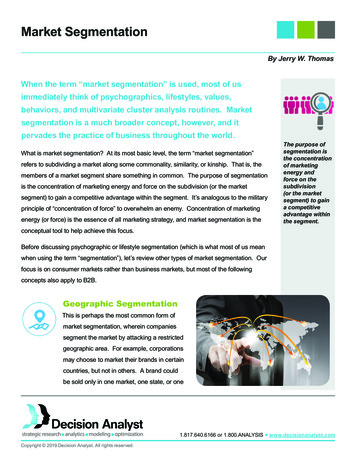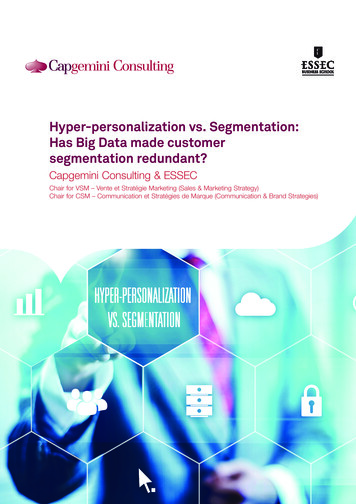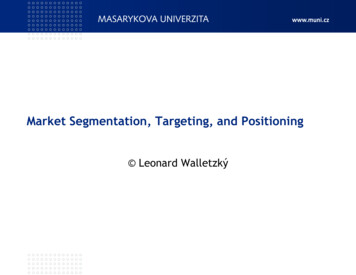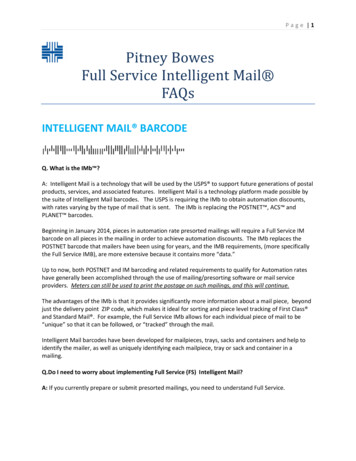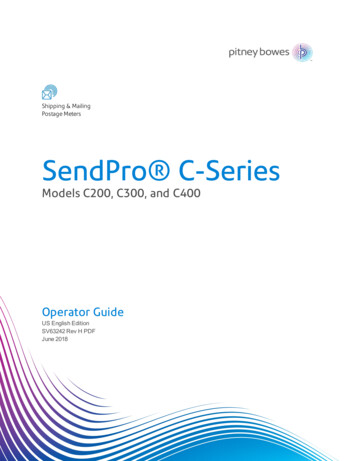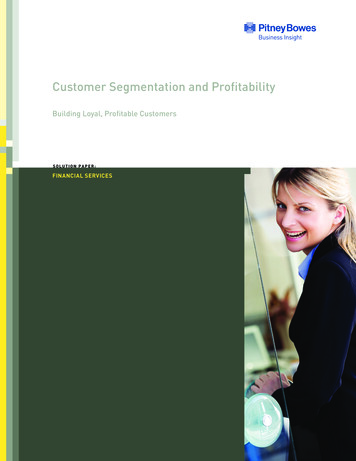
Transcription
Customer Segmentation and ProfitabilityBuilding Loyal, Profitable CustomersSOLUTION PAPER:FINANCIAL SERVICES
SOLUTION PAPER: FINANCIAL SERVICESCustomer Segmentation and ProfitabilityBuilding Loyal, Profitable Customers2ABSTRACTFINANCIAL INSTITUTIONS HAVE BEGUN THE PROCESS OF RECOVERY, AND ARE CAUTIOUSLY LOOKING FORWARD TO FUTURE GROWTH.WITH SLOW BUT CONTINUED GROWTH IN THE HOUSING AND JOB MARKETS, FORECLOSURES AND BANKRUPTCIES REMAIN HIGHPUTTING A CONTINUED STRAIN ON THE INDUSTRY. ADD TO THAT, NEW REGULATORY OVERSIGHT REQUIRES FINANCIAL INSTITUTIONSTO STRENGTHEN BOTH CONTROLS AND COMPLIANCE REPORTING. AS THE RECOVERY CONTINUES, FINANCIAL INSTITUTIONS LOOKTO IMPROVE BOTH THEIR EFFICIENCY RATIO AND CROSS-SELL AND UP-SELL OPPORTUNITIES, WHILE INSTITUTING SUCCESSFULPROCESSES TO BRING AND KEEP CUSTOMERS ONBOARD. IN EACH OF THESE CASES, THE KEYS TO SUCCESS ARE TO GROW REVENUESAND DEPOSITS WITHOUT ADDING EXPENSE, ALL WHILE OBTAINING AND EXTENDING CUSTOMER SATISFACTION AND LOYALTY.FINANCIAL INSTITUTIONS MUST DEAL WITH YET ANOTHER ASPECT OF THE ECONOMIC FALLOUT – CUSTOMER SATISFACTION. THE GLOBALBANKING LANDSCAPE HAS BEEN FOREVER CHANGED BY THE CREDIT CRISIS, LEAVING ISSUES OF TRUST, CUSTOMER ATTRITION, BRANDLOYALTY, AND THE RESULTING REVENUE DECLINES TRAILING IN ITS WAKE. TO ENSURE SUCCESS, FINANCIAL INSTITUTIONS, WHILEMARSHALLING RESOURCES TO RAISE CAPITAL AND CUT COSTS WHERE POSSIBLE, MUST NOT OVERLOOK THEIR LIFEBLOOD - ONGOINGACQUISITION, OPTIMIZATION, AND RETENTION OF CUSTOMERS. THE BOTTOM LINE IS THAT FINANCIAL INSTITUTIONS MUST IMPROVE THECUSTOMER EXPERIENCE TO KEEP CUSTOMERS HAPPY, SATISFIED, AND LOYAL.TO SECURE AND BOOST CUSTOMER RETENTION, WHILE MAINTAINING SUCCESSFUL RELATIONSHIPS, FINANCIAL INSTITUTIONS MUSTFIND NEW AND INNOVATIVE WAYS TO COMMUNICATE WITH CUSTOMERS. ADVANCES IN TECHNOLOGY HAVE FORCED INSTITUTIONS TOIMPLEMENT A WIDE RANGE OF COMMUNICATION VEHICLES – FROM WEB, MOBILE PHONE, AND EMAIL, TO TEXT MESSAGES AND SOCIALNETWORKING SITES – DEPENDING ON THE CUSTOMER’S PREFERENCE. FINANCIAL INSTITUTIONS MUST EMBRACE, IMPLEMENT, ANDTAKE ADVANTAGE OF THESE VARIOUS TYPES OF CHANNELS TO SUCCEED IN TODAY’S NEW CUSTOMER-DRIVEN ENVIRONMENT.www.pbinsight.com
FINANCIAL INSTITUTIONS MUST IMPROVE THE CUSTOMER EXPERIENCETO KEEP CUSTOMERS HAPPY, SATISFIED, AND LOYALOverviewUnderstanding the Lifecycle of a CustomerWhile most consumers need a banking relationship, theThe customer lifecycle can be divided into three functionaltop 25% of customers account for nearly all of a financialareas – acquire, optimize, and retain.institution’s profits. Financial institutions require reliableways to identify revenue potential, assess needs, personalizeThe acquisition phase consists of market research,cross-sell and up-sell activities, build loyalty, and offermarketing, and customer onboarding. It is critical forconvenient, effective service to the targeted, high-yieldfinancial institutions to maximize the relationship with theaccounts. Fortunately, financial institutions can employcustomer. Acquisition is the opportune time to determinethese same tactics to the remaining 75% of accounts tonot only the best customers, but what they need and howhelp build effective relationships that match both theto cross-sell. In fact, activities performed in the first 90bank’s and the customer’s needs. In other words, the lessdays, which is the time period that defines onboarding, areprofitable accounts require highly automated interactions,paramount to the success of the customer relationship.while the high-yield accounts benefit from differentiatedand better levels of service.Next is the optimization phase, which consists of customerprofitability, event-based marketing, cross-selling andAs financial institutions have come to realize, unprofitableup-selling, and channel network optimization. After the 90customers can be classified into the following three groups:day onboarding period, it is important to determine how to Unprofitable due to lack of profitable relationships Unprofitable due to improper charging or inappropriatemaximize and optimize networks and processes, and create/deliver relevant, cost-effective communications to best servethose customers and keep them loyal.servicing channels Truly unprofitableThe final phase, the retention phase, entails implementingTo avoid the unprofitable pitfalls, financial institutionsaccurate customer profiles. It is advantageous for financialmust implement processes and tools that enable them tocapture higher wallet share, migrate customers to more costeffective channels, and properly identify customers to beeffective retention and rationalization programs based oninstitutions to fully understand the identities of their twotypes of customers - their best and their less-than-best.These two customer groups are easily differentiated – thede-marketed or divested.best are the high-yield clients that the financial institutionsTo maintain a profitable relationship while driving thehigh-maintenance clients that the financial institutionpotential for sales, financial institutions must not only gaina true understanding of their customers, but they mustalso peer into the proverbial crystal ball to anticipate theirneeds.strive to retain, while the less-than-best are those low-yield,would benefit from divesting. As mentioned earlier, thetop 25% of high-yield accounts and the remaining 75% ofless profitable accounts can benefit from the same set ofprocesses and relationship building. In fact, instead of onlyfocusing on the high-yield accounts, financial institutionsmust innovate and look for ways to turn low-yield accountsinto profitable accounts.3
SOLUTION PAPER: FINANCIAL SERVICESCustomer Segmentation and ProfitabilityBuilding Loyal, Profitable Customers4Customer Profitability and SegmentationChallengesTo ensure successful and profitable relationships, financialinstitutions must understand their customers, anticipatetheir needs and requirements, and drive sales. Toto ensure clean and validated customer data, placethemselves in the best possible defensive position byknowing and validating their customer’s identity.Identifying and Understanding the Customeraccomplish these objectives, institutions must be able toFinancial institutions begin the customer profitability andanswer the following, all-important questions:segmentation process by gaining a full 360 view of their Who are my best customers? What products and services do they require? How do their product needs vary across regions andbranch trade areas? How can I package products, based on these needs, tomaximize value and corresponding fee revenue? How can I cultivate a better relationship throughcommunication? Which communication channels do they prefer?customers with clean, accurate data. This is critical asthey must learn how to uncover and then maximize theirmost valuable asset: tremendous amounts of customerinformation. Securing this foundation is necessary not onlyto successfully identifying the customer through accuratedata, but by understanding their needs and preferences.Clean data is the essential first building block upon which asuccessful strategy is built.To get clean, high-quality customer data, financialinstitutions must start by matching and consolidatingexisting data into a single, comprehensive customer record.This can provide the insight needed to enhance customerThese questions represent the fundamental challengesloyalty and lifetime value. Processes used within a customerfaced by every financial institution looking to successfullysegmentation and profitability solution can take a myriadimplement a customer profitability and segmentationof information from multiple customer touch-points;process. To get answers, institutions must address theupdate, link, and consolidate the data; secure identificationfollowing four areas:and compliance; then transform the information into Identifying and understanding the customer – both atenterprise-wide business intelligence.the macro/trade area level and the individual consumerlevel Maximizing customer potential and profitability Personalizing customer communications Delivering targeted communicationsAdditionally, financial institutions must be prepared toanswer two more questions, “Do I know the identity ofmy customer?” and “Can I validate that identity?” Theseanswers are essential to minimize fraud losses and tocomply with today’s stringent governmental requirements.Financial institutions that implement automated solutionswww.pbinsight.comDown the line, this rich customer information can helpfinancial institutions reap further benefits such as: Increasing customer loyalty through targetedcommunications Generating revenue with more effective cross-marketing,cross-selling, and up-selling Boosting campaign effectiveness through consolidatedcustomer profiling and householding Reducing marketing costs by eliminating redundantmailings
ANALYTICS, SPECIFICALLY PREDICTIVE ANALYTICS, UTILIZESLOCATION INTELLIGENCE TO PREDICT CUSTOMER BEHAVIORMaximizing Customer Potential andProfitabilityAnalytics, specifically predictive analytics, utilizes locationintelligence to predict customer behavior. By employingproven predictive analytic methodologies, financialOnce a financial institution has identified their customersinstitutions can:and ensured the accuracy of their customer data, thenext step is to maximize each customer’s potential and Gain unparalleled insight into marketsprofitability. This is a critical step, as it not only identifies Attract more profitable customersand rewards the best and most profitable customers, it, atthe same time, highlights the customers who would benefit Maximize investments in sales and delivery channelsfrom relationship expansion, product and service migration, Secure a competitive advantage in the marketplaceor divestiture. Distribute branches more effectivelyTo garner this insight and information, financialinstitutions must implement a solution that employsboth analytics and segmentation. This combination helpsinstitutions determine customer needs and behaviors, andaides in increasing customer value over time. Align branches with defendable strategic performancegoals rooted in real-world customer behaviors andcomprehensive market data Explore and quantify potential opportunities beforemaking the critical decisions that impact the bottom lineREVENUEMaximizing Customer ProfitabilityBetter cross /up-sellingRecovery ofpotentially valuablecustomer relationshipsMore efficientcustomer retentionAcquisitionOptimizationRetentionFaster terminationof potentially lessvaluable customerrelationshipsMore efficientacquisition ofnew customersCustomer LifecyclePeppers & Rogers GroupTIME5
SOLUTION PAPER: FINANCIAL SERVICESCustomer Segmentation and ProfitabilityBuilding Loyal, Profitable Customers6With clean, accurate data, financial institutions can nowBut, delivering personalized communications requires morebegin to get a 360 view of their customers. A detailed,than just manually tailoring a standard document template.chronological roadmap that focuses on predictive analyticFinancial institutions benefit greatly by implementing anmodels will help financial institutions:automated customer communication management (CCM) Optimize distribution networkssolution to leverage the insights made available fromsegmentation. Define untapped opportunities and maximize branchperformance through a better sales goal-setting process Analyze and visualize market opportunities for salesplanning activities Identify the next best purchase and profitability forindividual customers or new prospectsAdditionally, to identify how best to serve the mostprofitable customers, financial institutions must implementa distribution strategy. This strategy helps determine andAn effective, enterprise-wide CCM solution includes fourtypes of communications – high volume, on-demand,interactive, and multi-channel delivery. High volume communications are normally processed inbatch, pushing high transaction rates On-demand communications are created with availableexternal data, and delivered in real-time via web services Interactive communications are individualized, ad-hocutilize the communication vehicles preferred by customers,documents that require real-time information and awhile optimizing sales and forecast capabilities.human touch to completeTo benefit the financial institution and the customer,The fourth step in the CCM solution is not a type ofsimultaneously, these analytics and segmentation solutionscommunication, but a method of delivery. The abilitymust run in the background, integrating powerful analyticsto offer customers multi-channel delivery is critical inand analyzing data at the first point of contact - data entry.the quest to achieve the utmost satisfaction. Deliverymethod preferences vary significantly from customer toPersonalizing Customer CommunicationsHaving successfully implemented the processes neededto obtain clean, accurate customer data, and maximizethe customer’s potential, the next step is for financialinstitutions to implement capabilities that enableeffective marketing. This includes educating the customeron the next best sell, and the benefits of mutuallybeneficial transaction channels through personalized andtargeted communications. These effective, cost-efficientcommunications provide customers with the right message,via the right channel, delivered at the right time.These targeted customer communications are vital elementsto providing quality service, boosting the customerexperience, and improving loyalty and retention rates.www.pbinsight.comcustomer, so ensuring that processes are in place to delivercommunications via traditional print/mail, email, SMS,and fax, is important for financial institutions. Creatingcommunications plans by customer segment allows highcustomization to meet the preferences of high-yieldcustomers, while financial institutions can use a lessexpensive approach to communicate with their low-yieldcustomers.By employing the right solutions, financial institutions canenable one-to-one marketing by composing, delivering,and coordinating their choice of print, electronic, email,or mobile marketing campaigns through a central source.Institutions can maintain brand consistency acrosschannels, reduce duplicate efforts, and most importantly
THE ABILITY TO OFFER MULI-CHANNEL DELIVERY IS CRITICAL IN THEQUEST TO ACHIEVE THE UTMOST CUSTOMER SATISFACTIONincrease the ability to provide customers with thePitney Bowes Business Insight is the leading provider ofpersonalized financial guidance they desire.location intelligence and predictive analytic solutions forfinancial institutions worldwide, with more than 20 yearsDelivering Targeted CommunicationsAs the final aspect of the customer segmentation andprofitability solution, it is important to understand howenabling technologies, empowered by a 360 customer view,will improve the delivery of targeted communications.Direct mail contact with customers via monthly statementsand account updates can, of course, create huge postageand mailing expenditures. But by having targetedcommunications that utilize clean customer data, financialinstitutions can enhance marketing response rates, drivemailing efficiencies, and reduce related costs. In addition,insert, pre-sort, and delivery solutions can increaseefficiencies, improve customer communications, andmaximize postal savings.Ultimately, financial institutions can use their data to bettertarget marketing campaigns, sending finely honed messagesto customers via their preferred channels - be it print,online, email, or SMS. Not only will the marketing messagebe delivered, institutions can alert the right departmentsand sales staff when customer communications arereceived, enabling appropriate and timely follow-up.Together, these capabilities ensure cost-efficient deliveryof the very messages that will optimize both customersatisfaction and loyalty.Pitney Bowes Business Insight Leads the WayPitney Bowes Business Insight offers an end-to-endsolution that helps maximize customer segmentation andprofitability insight and efforts. Pitney Bowes BusinessInsight offers solutions - from both a technology andconsulting perspective - to help every step of the way.of experience delivering solutions specifically tailored tothe financial industry. More than 150 different financialinstitutions currently rely on our expertise, enablingthe implementation of successful and effective customersegmentation and profitability solutions.Pitney Bowes Business Insight’s innovative solutions providefinancial institutions with the insights needed to makemore informed decisions on critical aspects of the business– exactly what is needed in the never-ending quest forsustained profitable growth and customer satisfaction.7
UNITED STATESOne Global ViewTroy, NY comCANADA26 Wellington Street EastSuite 500Toronto, ON M5E ight.caEUROPE/UNITED KINGDOMMinton PlaceVictoria StreetWindsor, Berkshire SL4 1EG kASIA PACIFIC / AUSTRALIALevel 7, 1 Elizabeth PlazaNorth Sydney NSW 2060 pb.compbbi.china@pb.comwww.pbinsight.com.au 2010 Pitney Bowes Software, Inc. All rights reserved.Pitney Bowes Business Insight is a division of Pitney Bowes Software Inc. The Pitney Bowes logo is a registered trademark of Pitney Bowes Inc.Aura is a protected trademarks of Pitney Bowes Software Inc. All other brand names and trademarks are the property of their respective owners.92432 AM 1004
To get clean, high-quality customer data, financial institutions must start by matching and consolidating existing data into a single, comprehensive customer record. This can provide the insight needed to enhance customer loyalty and lifetime value. Processes used within a customer segmentation and profitability solution can take a myriad

